
Nepenthes spathulata is a tropical pitcher plant native to Java and Sumatra, where it grows at elevations of between 1100 and 2900 m above sea level. The specific epithet spathulata is derived from the Latin word spathulatus, meaning "spatula shaped", and refers to the shape of the lamina.
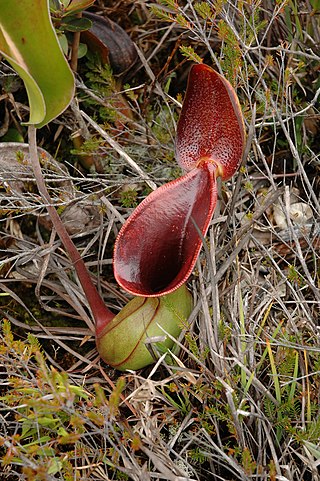
Nepenthes lowii, or Low's pitcher-plant, is a tropical pitcher plant endemic to Borneo. It is named after Hugh Low, who discovered it on Mount Kinabalu. This species is perhaps the most unusual in the genus, being characterised by its strongly constricted upper pitchers, which bear a greatly reduced peristome and a reflexed lid with numerous bristles on its lower surface.
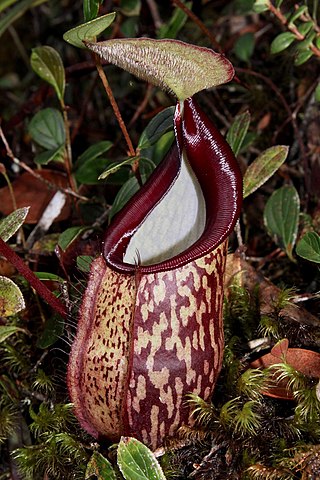
Nepenthes macfarlanei is a carnivorous pitcher plant species endemic to Peninsular Malaysia. It produces attractive red-speckled pitchers. Lower pitchers are ovoid or infundibular in the lower half and globose or cylindrical above and up to 25 cm high. Upper (aerial) pitchers are of a lighter colour with wings reduced to ribs. The lower surface of the lid is densely covered with short, white hairs. This is a characteristic morphological feature of this species, but at present its function is unknown.

Nepenthes hurrelliana is a tropical pitcher plant endemic to Borneo, where it has been recorded from northern Sarawak, southwestern Sabah, and Brunei. It is of putative hybrid origin; its two original parent species are thought to be N. fusca and N. veitchii. A thick indumentum of rusty-brown hairs covers the entire plant, a characteristic presumably inherited from the latter.
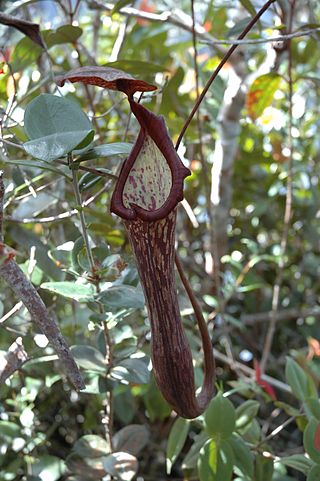
Nepenthes faizaliana is a tropical pitcher plant endemic to the limestone cliffs of Gunung Mulu National Park in Sarawak, Borneo. It is thought to be most closely related to N. boschiana.
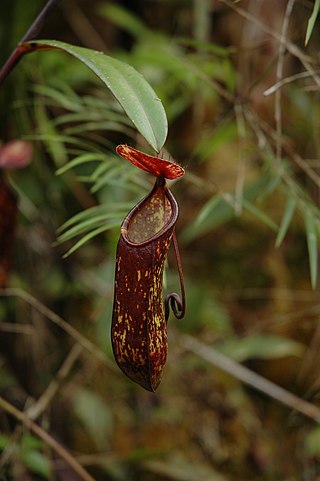
Nepenthes muluensis, or the Mulu pitcher-plant, is a tropical pitcher plant endemic to Borneo. It grows in highland habitats at elevations of 1700 to 2400 m above sea level.
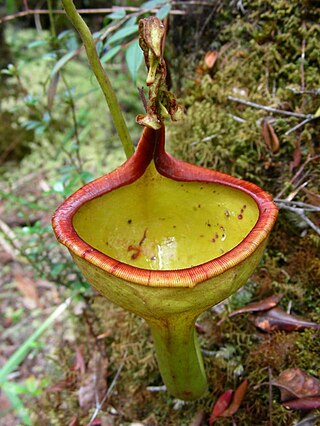
Nepenthes eymae is a tropical pitcher plant endemic to Sulawesi in Indonesia, where it grows at elevations of 1,000–2,000 m (3,300–6,600 ft) above sea level. It is very closely related to N. maxima, from which it differs in its wine glass-shaped upper pitchers.

Nepenthes lamii is a tropical pitcher plant endemic to New Guinea, where it grows at an altitude of up to 3520 m above sea level, higher than any other Nepenthes species. Although once confused with N. vieillardii and previously regarded as conspecific with the closely related N. monticola, it is now recognised as a distinct species.

Nepenthes rigidifolia is a critically endangered tropical pitcher plant endemic to Sumatra, where it grows at elevations of 1000–1600 m above sea level.

Nepenthes izumiae is a tropical pitcher plant endemic to Sumatra, where it grows in montane forest at 1700–1900 m above sea level. It appears to be most closely related to N. lingulata and N. singalana.
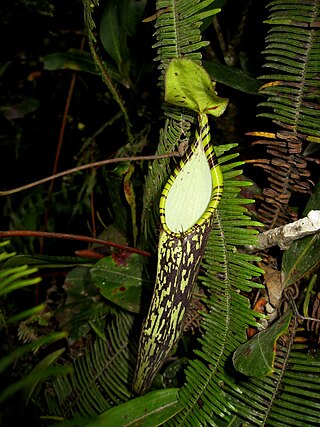
Nepenthes spectabilis is a tropical pitcher plant endemic to Sumatra, where it grows at elevations of between 1400 and 2200 m above sea level. The specific epithet spectabilis is Latin for "visible" or "notable".

Nepenthes kerrii is a tropical pitcher plant native to Tarutao National Marine Park in southern Thailand, where it grows at elevations of 400–500 m above sea level. The 2018 IUCN assessment also considers the taxon found on Langkawi Island of Malaysia to be conspecific. This species is thought to be most closely related to N. kongkandana. The specific epithet kerrii refers to Irish medical doctor Arthur Francis George Kerr, who made the first known herbarium collection of this species.

Nepenthes andamana is a tropical pitcher plant endemic to Phang Nga Province, Thailand, where it grows near sea level in coastal savannah and grassland. It is thought to be most closely related to N. suratensis.
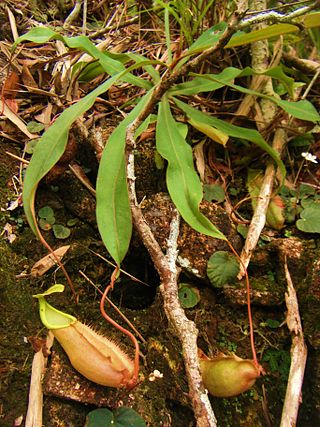
Nepenthes chang is a tropical pitcher plant endemic to the Banthad Mountains of central Thailand, where it grows at elevations of 300–600 m above sea level. It is thought to be most closely related to N. kampotiana.
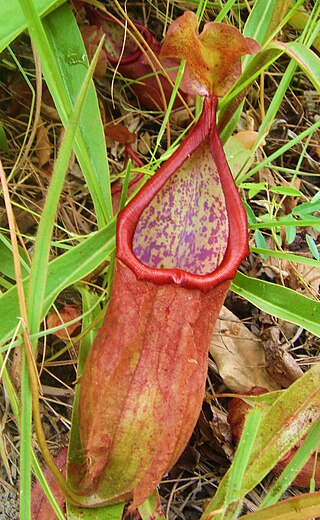
Nepenthes suratensis is a tropical pitcher plant endemic to Surat Thani Province, Thailand, where it grows near sea level in coastal savannah and grassland. It is thought to be most closely related to N. andamana.
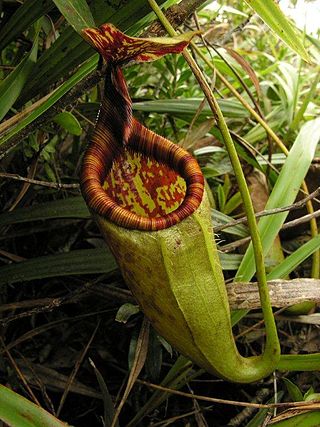
Nepenthes gantungensis is a tropical pitcher plant known from a single peak on the Philippine island of Palawan, where it grows at elevations of 1600–1784 m above sea level.
Nepenthes manobo is a tropical pitcher plant endemic in the Philippines discovered in the Pantaron Range on the island of Mindanao, where it grows at a narrow elevation range of 1000–1020 m above sea level.
Nepenthes berbulu is a tropical pitcher plant endemic to the Titiwangsa Range, in Peninsular Malaysia.
Nepenthes sericea is a tropical pitcher plant endemic to the north-central Titiwangsa Range in Peninsular Malaysia and is particularly known from Cameron Highlands. Nepenthes sericea was distinguished from Nepenthes macfarlanei by its pitchers having a dense covering of filamentous lid hairs that are 2 mm long or shorter, whereas the latter has pitchers with numerous thickened lid hairs that are 5–12 mm long. Also, the upper pitchers of N. sericea can either be entirely infundibular or funnel-shaped with a slight narrowing just below the peristome, or some plants may have a mid-point hip in their upper pitcher with the rest of the pitcher turning cylindrical to sub-infundibular in shape above the hip. In contrast, the upper pitchers of N. macfarlanei are generally wholly infundibular and may or may not have a hip present just below the peristome.
Nepenthes limiana is a tropical pitcher plant endemic to the northern Titiwangsa Range in Peninsular Malaysia. Nepenthes limiana was compared to Nepenthes sericea and Nepenthes sanguinea. The species differs from N. sericea by its upper pitchers being narrowly cylindrical which has an infundibular base with a pitcher hip on the lower part as compared to the wholly infundibular pitcher with a pitcher hip just below the mouth or pitchers that are basally infundibular turning cylindrical to slightly infundibular above the medial hip in N. sericea. Additionally, the narrowly oblanceolate to almost linear laminae that are slightly decurrent and the proportionally wider and bulbous peristome of the lower pitchers which are often flared and crenellated characterize this species from the sessile and oblanceolate to obovate-oblong laminae and the proportionally thinner peristome that are expanded near column only and not crenellated in N. sericea.















